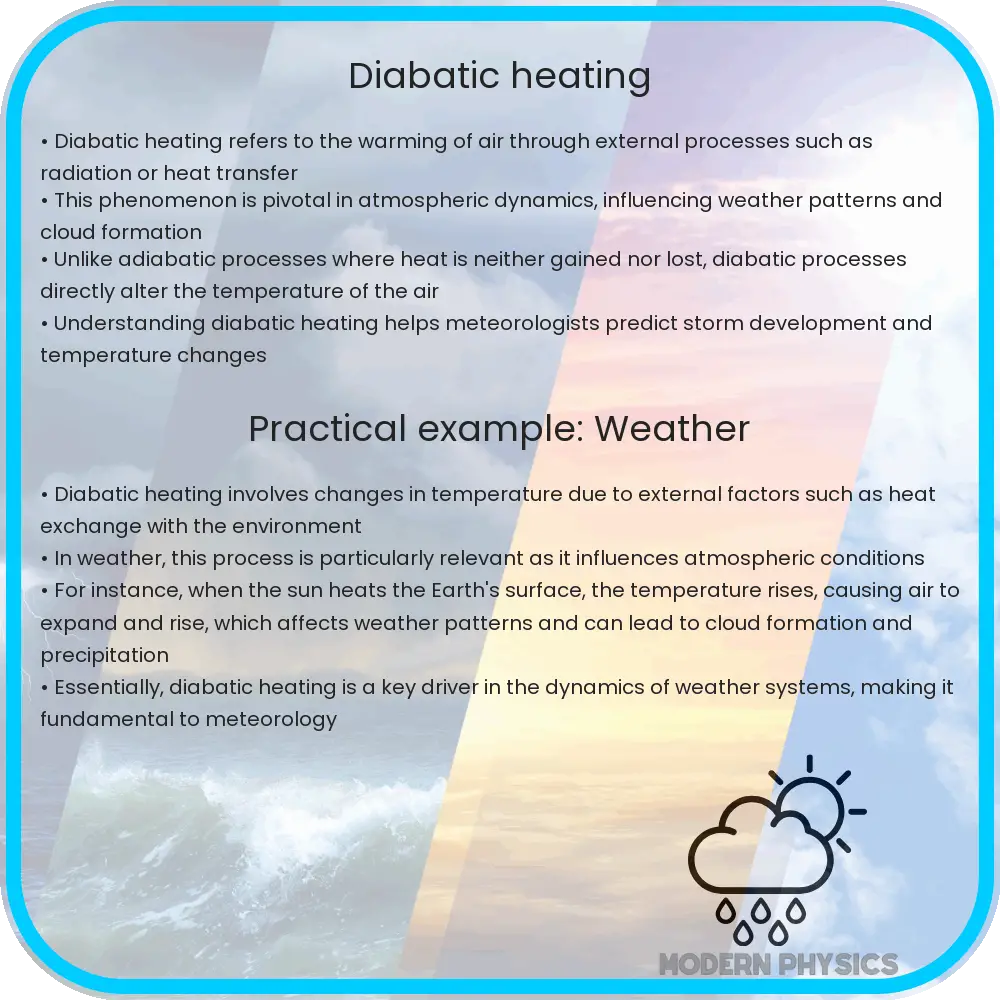Diabatic heating involves changes in atmospheric heat through energy addition or removal, influencing weather patterns and climate dynamics.

Understanding Diabatic Heating in the Atmosphere
Diabatic heating refers to the processes in the atmosphere that lead to a change in heat due to the addition or removal of energy. This form of heating plays a crucial role in meteorology and climatology, influencing weather patterns, storm development, and climate dynamics. Let’s explore how diabatic heating functions and impacts the atmosphere.
Atmospheric Role of Diabatic Heating
At its core, diabatic heating is about energy transactions within the atmosphere. Unlike adiabatic processes, which occur without any heat exchange with the environment, diabatic processes involve external heat sources or sinks. These can include:
- Latent heat release during condensation
- Radiative heating from the sun
- Heat exchange due to contact with the surface of the Earth
- Mixing of air masses at different temperatures
One of the most influential forms of diabatic heating is the release of latent heat when water vapor condenses into liquid water or solid ice. This release of heat is a major driving force in the development of storms and weather systems.
Impact of Diabatic Heating
The release or absorption of heat in the atmosphere due to diabatic processes can profoundly affect atmospheric pressure, temperature, and circulation patterns. For instance:
- Storm Development: Latent heat release during the condensation in a weather system can cause air to warm and rise, lowering pressure at the surface and intensifying the storm.
- Temperature Gradients: Variations in diabatic heating across different regions can create significant temperature gradients, which in turn drive wind and weather patterns.
- Long-term Climate Effects: Persistent diabatic heating differences can influence climate zones and potentially cause shifts in these zones over time.
Dynamics of Diabatic Heating
To fully grasp the dynamics of diabatic heating, it’s important to consider the equations that govern energy balance in the atmosphere. The fundamental equation is:
\[\text{Q = Q}_\text{rad} + \text{Q}_\text{sen} + \text{Q}_\text{lat}\]
Where:
- \[\text{Q}\] represents the total diabatic heating
- \[\text{Q}_\text{rad}\] is radiative heating or cooling
- \[\text{Q}_\text{sen}\] is sensible heat due to air-surface interaction
- \[\text{Q}_\text{lat}\] is latent heat release from phase changes of water
This equation shows how the various forms of heat transfer come together to impact the atmospheric energy state. Sensible and latent heats are particularly dynamic, capable of rapid changes that significantly influence weather patterns and systems.
By understanding these delicate balances and processes, meteorologists and climatologists can better predict weather and understand climate dynamics, providing crucial information for planning and preparedness in various sectors.
Monitoring and Prediction of Diabatic Heating
Advancements in technology and meteorology allow for the accurate monitoring and prediction of diabatic heating effects. Weather satellites play a critical role in this field, providing data on cloud cover, temperature profiles, and water vapor levels. This data is essential for constructing accurate weather models that forecast the development of storms and other weather-related phenomena.
- Satellite Observations: These offer large-scale views of atmospheric conditions, essential for identifying potential storm formations and understanding diabatic heating on a global scale.
- Numerical Weather Prediction (NWP) Models: These mathematical models use the equations governing atmospheric processes, including diabatic heating, to predict weather patterns days or even weeks in advance.
- Ground-Based Monitoring Stations: These provide detailed local data that help refine satellite data and model predictions, ensuring greater accuracy and locality in weather forecasts.
Educational and Practical Implications
A clear understanding of diabatic heating not only aids meteorologists but also educates the public about the complexities of weather phenomena and their potential impacts. Enhanced knowledge in this area can lead to more informed decision-making by individuals and governments, especially in response to climate change and natural disasters.
- Public Awareness and Safety: Educating the public about how diabatic heating influences weather can enhance safety and preparedness during extreme weather events.
- Policy Making: Better understanding can guide policymakers in crafting laws and regulations that consider the impacts of climate change and atmospheric phenomena on ecosystems and human populations.
- Scientific Research: Continued exploration in the dynamics of diabatic heating can help refine current climate models, leading to better predictions and strategies to mitigate climate change.
Conclusion
Diabatic heating is a fundamental concept in understanding the earth’s atmosphere and its various weather phenomena. Its influence stretches from the daily weather patterns we experience to long-term climate dynamics affecting the entire globe. Through continuous monitoring and advanced modeling, scientists can utilize this knowledge to predict and prepare for future atmospheric conditions. Moreover, widespread education on this topic enhances public awareness and helps societies adapt to a changing climate, optimizing the balance between human activities and natural atmospheric processes. Engaging with these concepts not only deepens our understanding but also equips us to face environmental challenges more effectively.
